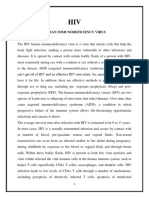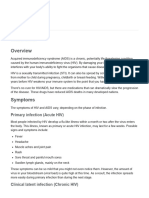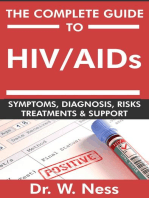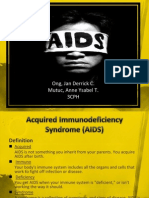What Is Hiv
What Is Hiv
Uploaded by
amirCopyright:
Available Formats
What Is Hiv
What Is Hiv
Uploaded by
amirOriginal Description:
Original Title
Copyright
Available Formats
Share this document
Did you find this document useful?
Is this content inappropriate?
Copyright:
Available Formats
What Is Hiv
What Is Hiv
Uploaded by
amirCopyright:
Available Formats
WHAT IS HIV
The HIV human immunodeficiency virus is a virus that attacks cells that help the
body fight infection, making a person more vulnerable to other infections and
diseases.
It is spread by contact with certain bodily fluids of a person with HIV, most
commonly during sex with a condom or sex without a condom HIV can lead to the
disease AIDS (acquired immunodeficiency syndrome).
The human body can’t get rid of HIV and no effective HIV cure exists. So, once you
have HIV, you have it for life.
In addition, there are effective methods to prevent getting HIV through sex or drug
use, including per-exposure prophylaxis (Prep) and post-exposure prophylaxis (PEP).
The human immunodeficiency viruses (HIV) are two species of Antivirus (a subgroup
of retrovirus) that infect humans.
Over time, they cause acquired immunodeficiency syndrome (AIDS), a condition in
which progressive failure of the immune system allows life-threatening opportunistic
infections and cancers to thrive.
The average survival time after infection with HIV is estimated to be 9 to 11 years.
In most cases, HIV is a sexually transmitted infection and occurs by contact with or
transfer of blood, per-ejaculate, semen, and vaginal fluids.
Non-sexual transmission can occur from an infected mother to her infant during
pregnancy, during childbirth by exposure to her blood or vaginal fluid, and through
breast milk.
Within these bodily fluids, HIV is present as both free virus particles and virus within
infected the vital immune cells in the human immune system, such as helper T cells
(specifically CD4+ T cells), macrophages, and dendrite cells.
HIV infection leads to low levels of CD4+ T cells through a number of mechanisms,
including apoptosis of abortively infected T cells, apoptosis of uninfected bystander
cells, direct viral killing of infected cells, and killing of infected CD4+ T cells by
CD8+ toxicity lymphocytes that recognize infected cells.
When CD4+ T cell numbers decline below a critical level, cell-mediated immunity is
lost, and the body becomes progressively more susceptible to opportunistic infections,
leading to the development of AIDS.
WHAT DAMAGE THE INFECTION CAN CAUSE
The different damage the HIV infection can cause are called :
-Pneumocystis pneumonia (PCP).
This fungal infection can cause severe illness.
PCP is still the most common cause of pneumonia in people infected with HIV.
-Candidiasis (thrush).
Candidiasis is a common HIV-related infection. It causes inflammation and a thick,
white coating on
your mouth, tongue, esophagus or vagina.
-Tuberculosis (TB).
TB is a common opportunistic infection associated with HIV. Worldwide, TB is a
leading cause of death
among people with AIDS.
-Cytomegalovirus.
This common herpes virus is transmitted in body fluids such as saliva, blood, urine,
semen and breast
milk. A healthy immune system inactivates the virus, and it remains dormant in your
body.
If your immune system weakens, the virus resurfaces, can cause damage to your eyes,
digestive tract,
lungs or other organs.
-Cryptococcal meningitis.
Meningitis is an inflammation of the membranes and fluid surrounding your brain and
spinal cord
(meninges).
Cryptococcal meningitis is a common central nervous system infection associated
with HIV, caused by
a fungus found in soil.
-Toxoplasmosis. This potentially deadly infection is caused by Toxoplasmosis, a
parasite spread
primarily by cats.
Infected cats pass the parasites in their stools, which may then spread to other animals
and humans.
Toxoplasmosis can cause heart disease, and seizures occur when it spreads to the
brain.
WHAT ARE THE SYMPTOMS OF HIV INFECTIONS
The symptoms of HIV and AIDS vary, depending on the phase of infection.
Primary infection (Acute HIV)
Some people infected by HIV develop a flu-like illness within 2 to 4 weeks
Most people experience a short flu-like illness 2 to 6 weeks after HIV infection after
the virus enters the body which lasts for a week or 2.
After these symptoms disappear, HIV may not cause any symptoms for many years,
although the virus continues to damage your immune system.
This means many people with HIV do not know they're infected as they're at
particularly high risk.
This illness, known as primary (acute) HIV infection,has
Possible signs and symptoms include:
-Fever
-Headache
-Muscle aches and joint pain
-Rash
-Sore throat and painful mouth sores
-Swollen lymph glands, mainly on the neck
-Diarrhea
-Weight loss
-Cough
-Night sweats
- Persistent, unexplained fatigue
-Swollen lymph glands
-Oral yeast infection (thrush)
-Shingles (herpes zoster)
-Pneumonia
-Progression to AIDS
-Sweats
-Chills
-Persistent white spots or unusual lesions on your tongue or in your mouth
-Weakness
-Weight loss
These symptoms can be so mild that you might not even notice them. However, the
amount of virus
in your bloodstream is quite high at this time. As a result, the infection spreads more
easily during primary infection than during the next stage.
Clinical latent infection (Chronic HIV).
In this stage of infection, HIV is still present in the body and in white blood cells.
However, many people may not have any symptoms or infections during this time.
This stage can last for many years. Some people develop more severe disease much
sooner.
HOW IS LIFE LIVING WITH HIV
If you're living with HIV, taking effective HIV treatment and being undetectable
significantly reduces your risk of passing HIV on to others.
You'll also be encouraged to:
-Take regular exercise
-Eat a healthy diet
-Stop smoking
-Stop having sex
There no remedy for HIV and AIDS because it a incurable disease, the immune
system will become severely damaged, and life-threatening illnesses such as cancer
and severe infections can occur.
WHAT ARE THE CAUSES OF HIV INFECTIONS
HIV is caused by a virus. To become infected with HIV, infected blood, semen or
vaginal secretions must enter your body this can happen in several way.
It can be transmitted by coming into direct contact with :
- By having sex
-Drug use
-The the body fluids of an infected person
-This includes semen
- Vaginal and anal fluids
-The blood
-Transmission from mother to baby during pregnancy, birth or breastfeeding
-Semen (cum) and pre-seminal fluid
-Kissing
-Touching
-Sharing anything with a HIV positive person And will be dependent on many things,
such as whether you receive or give oral sex and the oral of the person giving the oral
sex.
And the most common way of getting HIV is through having anal or vaginal sex.
HIV can be transmitted through sweat, urine or saliva.
It's a fragile virus and does not survive outside the body for long.
The HIV in these fluids must get into the bloodstream of an HIV-negative person
through a mucous membrane (found in the rectum, vagina, mouth, or tip of the penis);
open cuts or mouth sores; or by direct injection.
The virus can also enter your body through small tears that sometimes develop in the
rectum or vagina during sexual activity,drug paraphernalia puts you at high risk of
HIV and other infectious diseases, such as hepatitis, Or from blood transfusions.
The risk is high in ther upper-middle-income countries and low-income countries.
HOW CAN YOU PREVENT THE SPREADING OF THE HIV
There's no vaccine to prevent HIV infection and no cure for HIV/AIDS. But you can
protect yourself and others from infection.
To help prevent the spread of HIV by:
-Stop having sex
-Not touching contaminated people.
-Stop sharing everything with the HIV positive people.
-Stop hugging
-Avoiding being in contact with those that has AIDS in any shape or form
-Staying far away from HIV contaminated people
-Not sharing the same food or drinks
Choose to Stop risky sexual behaviors. By getting married to only 1 partner for life.
Stop the number of sexual partners and only choose 1 person to married
The more partners you have, the more likely you will catch HIV (STD).
Having an STD can increase your risk of getting HIV or spreading it to others and for
people who do not have HIV but who are at risk of getting HIV.
To reduce the risk of getting HIV through sex or drug use.
And also do not share your equipment with others.
You might also like
- Christian Dreams and Visions Free EbookDocument27 pagesChristian Dreams and Visions Free EbookChristieBeckley67% (3)
- Our Lady of Lourdes Academy of Tagkawayan, IncDocument4 pagesOur Lady of Lourdes Academy of Tagkawayan, IncJOSWINA CARRANZA100% (2)
- The GraduateDocument21 pagesThe GraduatepvkchakravarthiNo ratings yet
- Hiv Part 1 - MergedDocument24 pagesHiv Part 1 - MergedUma NagallaNo ratings yet
- RewriteDocument18 pagesRewriterosamindacavan28No ratings yet
- Hiv/AidsDocument5 pagesHiv/Aidsindonesiaserverid0003No ratings yet
- What Damage The Infection Can CauseDocument6 pagesWhat Damage The Infection Can CauseOluwaseunNo ratings yet
- Hivebolatuberculiosis DiabetesDocument18 pagesHivebolatuberculiosis DiabetesImDaniella DelBirutNo ratings yet
- Human Immunodeficiency Virus 1. What Is HivDocument6 pagesHuman Immunodeficiency Virus 1. What Is HiviqraNo ratings yet
- What Is HivDocument5 pagesWhat Is HivKim FortichNo ratings yet
- HIV and DiabetesDocument11 pagesHIV and Diabetesdiluclawrence3No ratings yet
- What Is HivDocument3 pagesWhat Is HivFly YtNo ratings yet
- Hiv & DiabetDocument7 pagesHiv & DiabetlafifaputrilarasatiNo ratings yet
- Human Immunodeficiency Virus Infection / Acquired Immunodeficiency Syndrome (HIV/AIDS) IsDocument4 pagesHuman Immunodeficiency Virus Infection / Acquired Immunodeficiency Syndrome (HIV/AIDS) IsL.a.ZumárragaNo ratings yet
- AidsDocument6 pagesAidsshamonicah0203No ratings yet
- AidsDocument27 pagesAidsbayabashealthcenter08No ratings yet
- HIV and AIDSDocument8 pagesHIV and AIDSmariam miladNo ratings yet
- Nikka Shanna Lingolingo Hiv (Document11 pagesNikka Shanna Lingolingo Hiv (ARISNo ratings yet
- Hiv/Aids: Products & ServicesDocument8 pagesHiv/Aids: Products & ServicesAziil LiizaNo ratings yet
- Hiv/Aids: Products & ServicesDocument8 pagesHiv/Aids: Products & ServicesAziil LiizaNo ratings yet
- DefinitionDocument15 pagesDefinitionSimona IonitaNo ratings yet
- Estimated HIV/AIDS Prevalence Among Young Adults (15-49) by Country As of 2008. UNAIDS 2008 ReportDocument16 pagesEstimated HIV/AIDS Prevalence Among Young Adults (15-49) by Country As of 2008. UNAIDS 2008 Reportlianghoo94No ratings yet
- HIV AIDS CausesDocument9 pagesHIV AIDS Causescamelapedro574No ratings yet
- What Is HIV? ExpandedDocument4 pagesWhat Is HIV? ExpandedAlyannaBesares100% (1)
- The Complete Guide To HIV / AIDs: Symptoms, Diagnosis, Risks, Treatments & SupportFrom EverandThe Complete Guide To HIV / AIDs: Symptoms, Diagnosis, Risks, Treatments & SupportNo ratings yet
- What Is HIV.Document2 pagesWhat Is HIV.Chiranth ChandNo ratings yet
- Artikel B. InggrisDocument9 pagesArtikel B. Inggrisbb dias0% (1)
- Hiv Aids: Presented By: Chavez - Galang - Kaur - Noguera 2DcnDocument24 pagesHiv Aids: Presented By: Chavez - Galang - Kaur - Noguera 2DcnKate ChavezNo ratings yet
- Introduction To Hiv Notes by Pauline MainaDocument15 pagesIntroduction To Hiv Notes by Pauline MainaLarzie DàSilva OmwochaNo ratings yet
- What Is HivDocument28 pagesWhat Is HivIrene Soriano BayubayNo ratings yet
- Introduction: What Is Hiv and Aids?Document6 pagesIntroduction: What Is Hiv and Aids?Hasib AhmedNo ratings yet
- HIV DocumentationDocument10 pagesHIV DocumentationSpidyNo ratings yet
- How Does HIV Affect Our Body?Document6 pagesHow Does HIV Affect Our Body?SwTJerome/ /CyberKnightNo ratings yet
- What Is HIVDocument14 pagesWhat Is HIVmariam miladNo ratings yet
- Causes, Incidence, and Risk Factors: HIV DiseaseDocument8 pagesCauses, Incidence, and Risk Factors: HIV DiseaseAminath SamaNo ratings yet
- Causes, Incidence, and Risk Factors: Acquired Immune Deficiency SyndromeDocument7 pagesCauses, Incidence, and Risk Factors: Acquired Immune Deficiency SyndromePriyanka RaniNo ratings yet
- Human Immunodeficiency Virus (HIV)Document7 pagesHuman Immunodeficiency Virus (HIV)Ambar WulanNo ratings yet
- Causes: HIV DiseaseDocument7 pagesCauses: HIV Diseasecsy123No ratings yet
- Human Immunodeficiency Virus (HIV) and Acquired Immunodeficiency Virus (AIDS)Document6 pagesHuman Immunodeficiency Virus (HIV) and Acquired Immunodeficiency Virus (AIDS)Shaqhandar MaadilNo ratings yet
- Contemporary Issues in Public Health - Diya Deborah AdebowaleDocument6 pagesContemporary Issues in Public Health - Diya Deborah AdebowaleDeborah BanjoNo ratings yet
- Hiv ElisaDocument3 pagesHiv ElisaRasikNo ratings yet
- HIV Infection and AIDS: An Overview: U.S. Department of Health and Human Services Contact Us - en EspañolDocument9 pagesHIV Infection and AIDS: An Overview: U.S. Department of Health and Human Services Contact Us - en EspañolLorraine AtienzaNo ratings yet
- HIV AwarenessDocument35 pagesHIV AwarenessCadine DavisNo ratings yet
- Hiv and Aids: Last Reviewed: 06/21/2011Document10 pagesHiv and Aids: Last Reviewed: 06/21/2011Kak DhenyNo ratings yet
- Symptoms of HIVDocument2 pagesSymptoms of HIVVinny Kartika ANo ratings yet
- By: Axel Jusuf (1461050177)Document9 pagesBy: Axel Jusuf (1461050177)AxelJusufNo ratings yet
- Hiv Immunology Study CaseDocument7 pagesHiv Immunology Study Casetan choonNo ratings yet
- Ong, Jan Derrick C. Mutuc, Anne Ysabel T. 3CphDocument31 pagesOng, Jan Derrick C. Mutuc, Anne Ysabel T. 3Cphtrixie_mutucNo ratings yet
- Assignment AidsDocument11 pagesAssignment AidsYousaf ManzoorNo ratings yet
- Expose AidsDocument7 pagesExpose AidsKouadio Bi RichardNo ratings yet
- AidsDocument2 pagesAidsMei-mei ZhuangNo ratings yet
- What Is Hiv ProjectDocument10 pagesWhat Is Hiv ProjectScience,Physical Education And Sports VideosNo ratings yet
- Documentation IN: Nursing Competency AppraisalDocument6 pagesDocumentation IN: Nursing Competency AppraisalPat PalomarNo ratings yet
- Hiv & AidsDocument4 pagesHiv & AidsAngelica Maeriz MindoroNo ratings yet
- Primary Infection (Acute HIV) : SymptomsDocument5 pagesPrimary Infection (Acute HIV) : SymptomsFauzyah WidyaNo ratings yet
- HIVAIDSDocument66 pagesHIVAIDSomarmamluky254No ratings yet
- "AIDS": School Name Biology Project File 2016-2017Document23 pages"AIDS": School Name Biology Project File 2016-2017Manish KarnaniNo ratings yet
- HIV Puterisalma A5 1810105056Document4 pagesHIV Puterisalma A5 1810105056Salma Puteri PermatasariNo ratings yet
- AdisDocument27 pagesAdisANIL KUMARNo ratings yet
- What Is AIDS?Document7 pagesWhat Is AIDS?Bhavya PNo ratings yet
- Kendriya Vidyalaya Ambernath BiologyDocument39 pagesKendriya Vidyalaya Ambernath BiologyROHIT SIHRANo ratings yet
- Hiv AidsDocument2 pagesHiv AidsPRINTDESK by DanNo ratings yet
- Bloodborne Pathogens PDFDocument11 pagesBloodborne Pathogens PDFAqib SatarNo ratings yet
- LOVE AND THE LAW - Charlie Orly December 9-11-2009Document13 pagesLOVE AND THE LAW - Charlie Orly December 9-11-2009Jack Ryan0% (1)
- Creative Nonfiction Exam WeaponDocument3 pagesCreative Nonfiction Exam WeaponAlfred Abay-abayNo ratings yet
- Carlos vs. AngelesDocument2 pagesCarlos vs. AngelesHanamichi Sakuragi Goku San0% (1)
- Ulangan Harian IDocument4 pagesUlangan Harian IUlan HandayaniNo ratings yet
- Believer (Imagine Dragons) - 2017Document1 pageBeliever (Imagine Dragons) - 2017James DerekNo ratings yet
- Guidelines - Research Article Introduction - Capstone Requirement & RubricDocument3 pagesGuidelines - Research Article Introduction - Capstone Requirement & Rubriccyrene rufoNo ratings yet
- Heather Farm Park Picnic Table BrochureDocument2 pagesHeather Farm Park Picnic Table Brochuresdivya02No ratings yet
- Pre-Test - Science 4Document4 pagesPre-Test - Science 4Jonalyn AntonioNo ratings yet
- Jinnah GandhiDocument3 pagesJinnah GandhiAbdullah Amir100% (1)
- Como Misturar Tris Base e Tris HCL para Preparo de Solução TampãoDocument4 pagesComo Misturar Tris Base e Tris HCL para Preparo de Solução TampãoVanderlei LimaNo ratings yet
- Privilige To WithholdDocument33 pagesPrivilige To WithholdSanjeetHoodaNo ratings yet
- Frame: H16.00-22.00XM-12EC (H400-500HD/HDS-EC) (B214)Document24 pagesFrame: H16.00-22.00XM-12EC (H400-500HD/HDS-EC) (B214)duyhp231296No ratings yet
- Draft Business PlanDocument7 pagesDraft Business Planamirfahmi06No ratings yet
- Fortification of Rice: A. P. State Civil Supplies Corporation LimitedDocument9 pagesFortification of Rice: A. P. State Civil Supplies Corporation Limitedcharsaubees420No ratings yet
- Study Guide For MGR Exam 2 PDFDocument10 pagesStudy Guide For MGR Exam 2 PDFRandyNo ratings yet
- CV Nikola MitrovicDocument2 pagesCV Nikola MitrovicnidzomirNo ratings yet
- ENGEN - PLAY ON - COMBINED PLANS - 19 August 2020 PDFDocument15 pagesENGEN - PLAY ON - COMBINED PLANS - 19 August 2020 PDFMasibulele S'khoma SukaziNo ratings yet
- West European Politics: Please Scroll Down For ArticleDocument23 pagesWest European Politics: Please Scroll Down For Articleml1607No ratings yet
- 5.1y Review WorksheetDocument2 pages5.1y Review WorksheetDyuNo ratings yet
- Spirituality in Architecture For IndDocument24 pagesSpirituality in Architecture For Indgkavin616No ratings yet
- Stella抯 Missing ScarfDocument6 pagesStella抯 Missing ScarfPhatz VirataNo ratings yet
- CE 518 NotepdfDocument56 pagesCE 518 NotepdfVictor Musa OgimaNo ratings yet
- 1.007 - Tsf1007r01 - Daily Checklist CertificationDocument1 page1.007 - Tsf1007r01 - Daily Checklist CertificationBilly EresNo ratings yet
- Effective Augmentative and Alternative CommunicatiDocument64 pagesEffective Augmentative and Alternative CommunicatiAnelia CibuNo ratings yet
- Principles of Develpment EconomicDocument24 pagesPrinciples of Develpment EconomicKim AutoNo ratings yet
- English 9Document5 pagesEnglish 9SHERYL100% (1)
- Natural Lighting in Building DesignDocument19 pagesNatural Lighting in Building DesignSiddhant VoraNo ratings yet

























































































